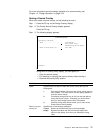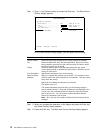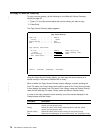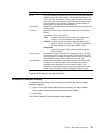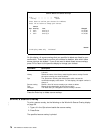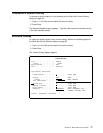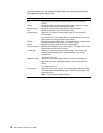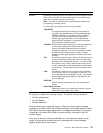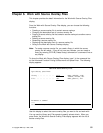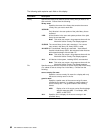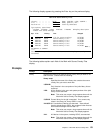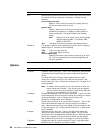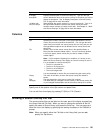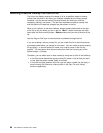
An overlay is created from a source overlay. The source overlay consists of:
Overlay specifications
Font information
Element definitions
Press the Enter key to create the overlay. When the overlay object is created
successfully, the Work with Source Overlays display or the screen before the Work
with Source Overlays display appears with a message at the bottom of the screen.
It depends on the value of the
Return to source overlay list
prompt in the Exit
Overlay display.
If any error is found in the input parameters or in the resource selection on the
screen, the field which contains the error is reversed and an error message
appears at the bottom of the screen.
Field Name Description
Authority Specifies the authority given to users who do not have specific authority
to the overlay, who are not on the authorization list, and whose user
group has no specific authority to the overlay.
Note: This value is ignored and the current authority remains if you
are replacing an existing overlay.
You can specify the following values for this parameter:
*LIBCRTAUT
The system determines the authority for the overlay by
using the value specified on the
Create authority
prompt
(CRTAUT parameter) on the Create Library command
(CRTLIB) for the library containing the overlay to be
created. If the value specified on the
Create authority
prompt (CRTAUT parameter) is changed, the new value
will not affect any existing overlays.
*CHANGE Change authority allows the user to perform all operations
on the overlay except those limited to the owner or
controlled by object existence authority and object
management authority. The user can change the overlay
and perform basic functions on the overlay. Change
authority provides object operational authority and all data
authority.
*ALL All authority allows the user to perform all operations on the
overlay except those limited to the owner or controlled by
authorization list management authority. The user controls
the existence of the overlay, specifies the security for the
overlay, changes the overlay, and performs basic functions
on the overlay. The user cannot transfer ownership of the
overlay.
*USE Use authority allows the user to perform basic operations
on the overlay, such as run a program or read a file. The
user is prevented from changing the overlay. Use authority
provides object operational authority, read authority, and
execute authority.
*EXCLUDE
Exclude authority prevents the user from accessing the
overlay.
Authorization-list-name
Specifies the name of the authorization list that is used to
secure the overlay object to be created.
Chapter 5. Work with Source Overlays 79



